4 Front Squat Benefits That Will Make You Add It to Your Routine
Author:
Reviewed by:
(21 years of Oly Lifting experience)
Unlock your full potential by engaging with our experts and community! Have questions about your fitness journey or looking for expert advice on weightlifting techniques? Don’t hesitate — leave a comment below and Sergii Putsov will provide a personalized answer and insights to help you reach your goals.
Torokhtiy is reader-supported. Some links are affiliate links, and we may earn a commission at no extra cost to you. See our disclosure page for details.
The front squat is a highly recommended exercise, be it for recreational athletes, weightlifting enthusiasts, or players of diverse sports. But what are front squats good for and why are they so popular?
Front squat benefits extend beyond building raw strength building. The dynamic nature of the movement also promotes better balance, posture, and endurance, which will translate well into daily life and sports. This article will teach you how and why this exercise works to help you better incorporate it into your workouts.
The front squat benefits your body in many ways: As a resistance exercise, it’s excellent for building strength, muscle growth, and conditioning. The dynamic movement also promotes balance, mobility, and explosive power. Those are the basic benefits of front squats.
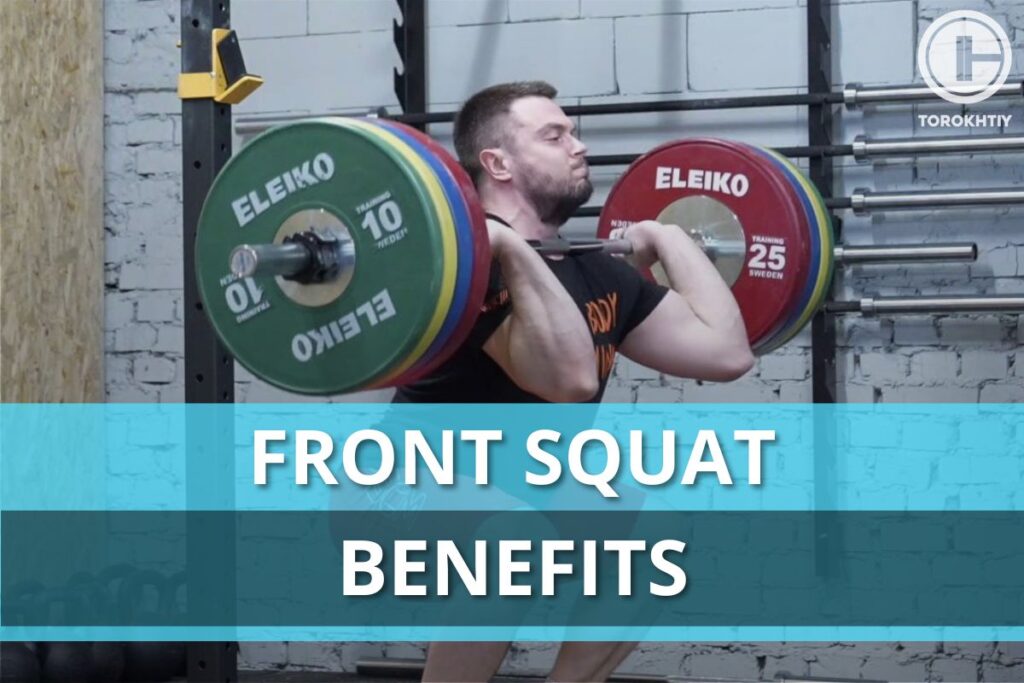
Front Squat: What Is It & How Does It Work?
The front squat is one of the two basic squat exercises, alongside the back squat. It’s named this way because the weight you use for resistance is balanced in front of your body. Front squats are a compound exercise, meaning they incorporate various muscle groups into one movement.
The exercise primarily targets the lower body, including the quadriceps, hamstrings, and glutes, but the core muscles also play a pivotal role in successfully executing the move.
During front squats, the bar follows a straight line vertical path, tracking over the midfoot throughout the entire exercise. The upper torso does the same, following a strict up-and-down motion.
The movement is executed by bending at the knees and extending the hips back, then rising back up in a reverse motion.
When observing the front squat from the side, it may seem as though the athlete is supporting the weight with their hands; however, this is not the case. No weight should be actively carried by the arms during a front squat.
In the starting position, with the barbell resting on your shoulders and collar, you should be able to release your grip, and the barbell will seamlessly rest between your shoulders and collarbone. The only active duty of your arms is balance.
The Technique Of Front Squats
Front squats can appear easy at first glance, but proper technique includes little details on posture and positioning that might not be obvious to the naked eye. Here’s a step-by-step explanation of the front squat technique.
Note that we’re going to talk about a traditional barbell front squat used in weightlifting. However, tips past the “grip” phase remain the same for other forms of resistance (dumbbells, kettlebells, sandbags) and the classic gym squat machine.
1. Setup
Start by racking your barbell at roughly shoulder level. The ideal spot for most people is between the collarbone and the middle shoulder. If you rack it higher than this, you won’t be able to safely unmount without raising your feet off the ground, which is a safety hazard (feet must remain planted at all times). If you rack it lower, it will require greater balance and energy to unmount, which can be impactful.
2. Grip
Place your hands on the barbell and approach it from underneath. As you do this, rotate your shoulders inward and raise your elbows. The elbows should stick out beyond the bar and must remain vertical to the floor through the movement. Rest the barbell on your shoulders and collar line and lift it off by rising up.
3. Posture
Stand with your feet at width. Point your toes slightly outward, between 10-30 degrees, this will improve your balance and reduce some knee stress. Keep your chest up and your torso straight.
4. Descent
Now you’re ready to initiate the downward movement AKA the descent. Start by simultaneously bending at the knees and pushing back with your hips. As your knees go lower, your hips should move backward.
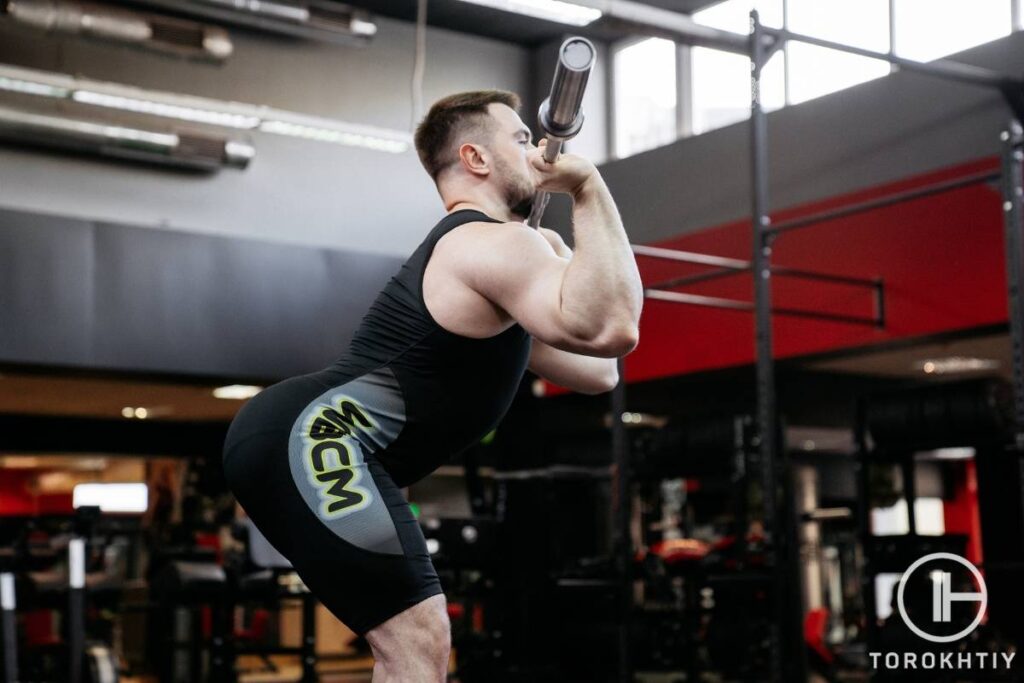
5. Depth
Squat depth will vary based on the exercise goal. The general technique involves lining up your knees and hips parallel to the ground. There’s also the half squat, in which the movement ends roughly before things become parallel with the ground.
Finally, the deep squat, which involves your hips passing well below the knees and essentially sitting on your ankles.
6. Ascent
Once you’ve reached the lowest point of your squat, it’s time to rise back up AKA the ascent phase. The simplest way to explain it is just reversing the descent motion. But it’s important to plant your feet firmly and generate force through the heel to maintain ground contact. Like with the descent, the torso remains straight the entire time.
The number of repetitions will depend on your exercise goals. If you feel your form slipping, lower the amount of weight. Proper breathing during the squat involves taking in breaths as you descend and exhaling forcefully as you ascend.
Tips From the Champ
Some athletes find the basic front squat grip difficult due to insufficient shoulder, elbow, or wrist mobility. If that’s the case for you, try the cross grip instead. Approach the barbell from underneath with arms extended forward. Once you hang the bar on your shoulders, create a crossover with your arms by placing them on the opposite elbow.
Olympic Weightlifting Champion
4 Benefits Of Front Squats
So, what are front squats good for, exactly? Here are some of the proven benefits of doing front squats:
✅ Muscle Growth & Hormone Production
Okay, so we know that squatting can increase our muscles, but what do front squats work on, exactly? Resistance training at high weight volume, with moderate or high intensity, and short rest intervals raises levels of testosterone and growth hormones (GH), promoting muscle growth. Furthermore, the study suggests the effects are greater with exercises targeting large muscle groups, which squats, a compound exercise, do.
Moreover, free weight training such as squats has been shown to have an increased hormonal response compared to machine exercises. So, if you want faster and more efficient lower-body gains, squats are perfect. This is why expert coaches typically recommend 3-4 sets of about 10 reps at near maximum but manageable weight.
Follow us!

Free!
Get a 2-week Weightlifting Program as a bonus for the subscription to kickstart your training plan!

Free!
✅ Exercise Versatility
Front squats are great because they can easily be adapted to fit different exercise purposes. All you have to do is play around with weight and repetitions and you’ll get differing results. According to research on load recommendations:
- Low repetitions (1-6) with higher weight (80% of your maximum) are best for strength development
- 8-12 reps of medium weight (60-80% of your maximum) are best for muscle hypertrophy (growth)
- 15 or more repetitions with a load below 60% of your maximum are best for conditioning
Adapt this into your squat routine and you can have one exercise covering various fitness aspects.
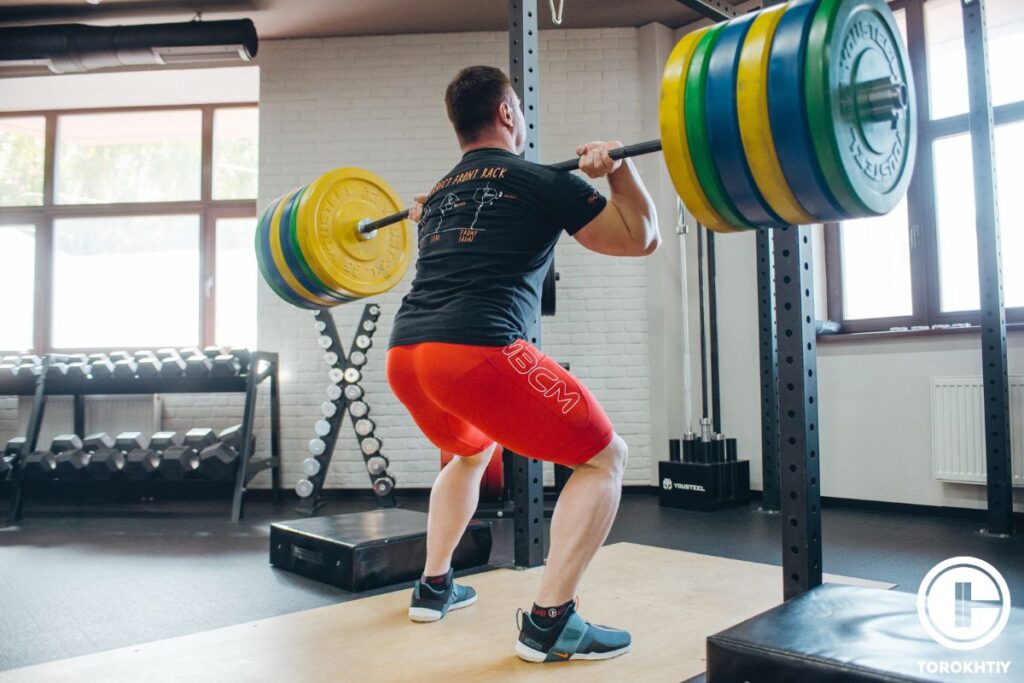
✅ Core Strength & Posture
Balancing the barbell on your shoulders during front squats requires a great deal of core engagement to maintain a straight torso. This not only includes the front and side abdominal wall but also the crucial spine supporting muscles on the back. So, not only is your core getting stronger, but you’re also exercising proper posture and fostering back strength and long-term spine health.
✅ Transferable Functionality
Squats are dynamic, meaning they’re not just good for raw strength and mass building. The complex motion necessary to perform a squat requires synergistic and multidirectional movement and multiple body parts.
This results in training your agility, stability, balance, explosiveness, mind-muscle connection, and proprioception (muscle awareness), among other things. All this to say that doing squats has benefits transferable to everyday life and professional sports.
For example, performing deep squats has been linked to increased speed jump speed and strength.
Tips From the Champ
Front squats are trickier than they look. Use a mirror to carefully assess your position and judge your technique. If you don’t have a mirror yet, use your front phone camera. Furthermore, if you work out alone, it’s a good idea to record yourself from multiple angles to analyze your progress.
Olympic Weightlifting Champion
What Muscles Work When Performing Front Squats?
The main area targeted by them is, of course, the lower body. The primary muscle engaged in a front squat is the Quadriceps (front thigh) muscles, often called quads for short.
The muscle activates the most during the ascent phase to extend the knee back up. Core muscles including the rectus abdominis, obliques, and transverse abdominis, are also highly active to stabilize the spine and maintain an upright torso position.
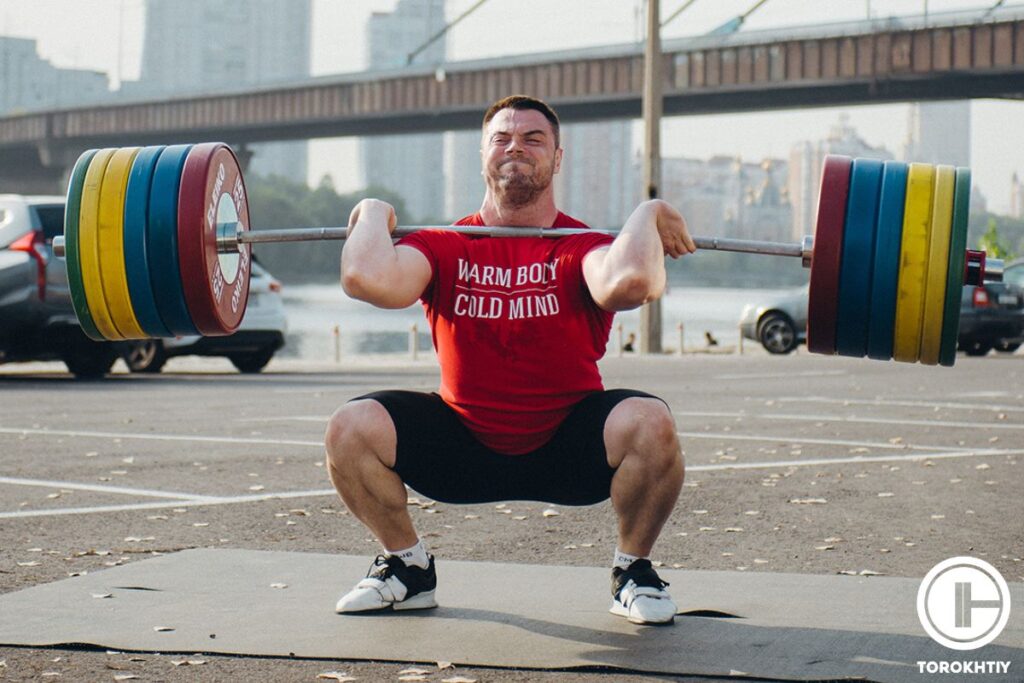
Secondary muscles include the Hamstrings AKA back thigh muscles and Gluteal muscles AKA glutes AKA buttocks. These muscles are pivotal for controlling hip movement during the descent and ascent.
Alongside, the hip Adductors (inner thigh muscles) work to keep the knees from collapsing forward. Finally, we have the Erector Spinae and Deltoids which, although not actively engaged in movement, carry the exercise weight and play a stabilizing role.
🔻GET A FREE PROGRAM DEMO: 12 Week Squat Program by Oleksiy Torokhtiy
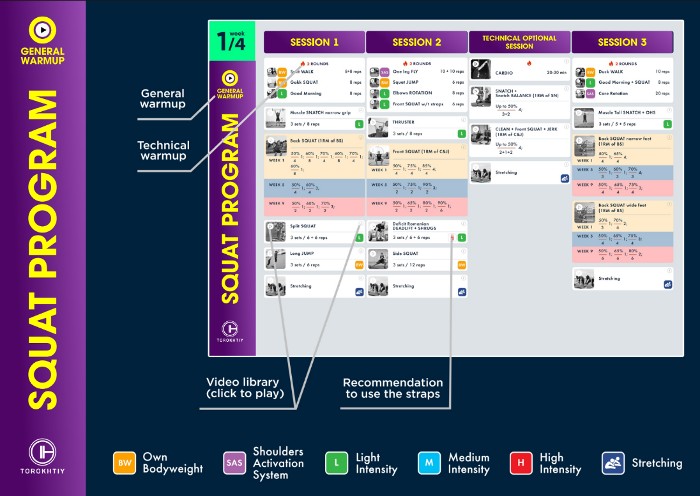
Do you want to double your squat strength? In just 12 weeks, you’ll be able to boost your squat results.
Enter your details and get a free demo (1 free week) of the squat program straight into your inbox.
Front Vs. Back Squats: Which Is Better For You?
A common question beginners pose is what do front squats work out that back squats don’t and vice versa. The short answer is that they mostly overlap, but there are noteworthy differences.
The main muscle group targeted by front squats is the quadriceps. They carry the brunt of the weight throughout the movement. Less involved, but still very active are the hamstrings and glutes. The torso is straight and aligned throughout the movement, and the center of the weight is frontal.
The barbell does not sit directly on the spine, lowering back stress. They’re also easier on the knees. That said, core activity is greater to compensate and balancing is more difficult.
Meanwhile, back squats primarily target the entire posterior chain, which includes the quadriceps, hamstrings, glutes, and erector spinae (lower back). There is a slight torso lean to rest the weight properly, giving it a lower center of balance, but also more stress on the back.
The spinal erectors are being pushed down directly, meaning more weight is carried by the back too. Depending on your exercise goals, this can be both a good and bad thing.
Front squats have a steeper learning curve because there are more things to be mindful of and there is a greater emphasis on mobility and balance. People are naturally more familiar with carrying weight on their back, for example, from carrying backpacks. For this reason, many novice squatters start with the back squat.
However, front squats are generally considered safer to do than back squats, especially when training alone. If something goes wrong, you can simply drop the weight in front of you.
Worst case scenario, some floor & equipment damage. Meanwhile, if something goes wrong with back squats, the possibility of the weight collapsing on you is always there, which can lead to spinal overload and some serious injuries.
If we had to summarize the differences between front and back squats, it would look something like this:
| Metric | Front Squat | Back Squat |
|---|---|---|
| Main Muscle Groups | Quadriceps, core | Posterior chain (quads, hams glutes) |
| Secondary Muscle Groups | Hamstring, gluteus, adductors | Core |
| Back (spine) stress | Lower | Higher |
| Knee stress | Lower | Higher |
| Core engagement | High | Moderate |
| Average carrying capacity | Lower | Higher |
| Point of balance | Frontal | Central |
| Exercise Safety | Higher | Lower |
| Learning curve | Higher | Lower |
| Execution difficulty | Higher | Moderate |
| Commonly done with | Barbell, dumbbell, kettlebell, sandbag | Barbell, backpack |
FAQ
Is Front Squatting Better For Knees?
Studies looking at the effects of front and back squats on knee behavior have confirmed that front squats put less pressure on the knees. This suggests front squatting is better for joint health, especially for individuals with knee issues.
Do Front Squats Build Mass?
Absolutely, front squats are great for building muscle because they target multiple muscle groups, resulting in efficient gains. However, it’s important to mention that the key component of muscle mass is calorie intake. Just training alone may not be enough to see major growth, you’ll have to eat more as well.
Conclusion
Those were the benefits of front squats. Many people are scared to try them or do them periodically because weightlifting still carries the stigma of being exclusively about strength and massive weight numbers. But with proper implementation, front squats can slot into any exercise regimen, be it for muscle and strength gain or functional fitness.
Front squat benefits range from efficiently exercising your lower body for strength and muscle gain to improved balance and stability, and better posture & healthier backs. The motion facilitated during squats easily transfers to everyday activities like walking and picking up objects to athletic movements like sprinting and jumping.
Now we’d like to hear from you. Do you practice squats? If so, tell us how they fit into your workout. Leave a comment with your answer and remember to follow us on social media for more valuable fitness content.
Also read:
- 10 Best Front Squat Alternatives for Home and Gym
- Front Squat Grip Secrets – Techniques & Tips
- Front Squat vs Back Squat: Do You Need Both?
- Front Squat Wrist Pain: 7 Reasons & Solutions
- What Muscles Do Squats Work? (Lifting Coach Explains)
- Spotter’s Handbook: How to Spot a Squat?
- How to Breathe During Squats? Techniques and Exercises
- Safety Bar Squats: Form & Benefits Explained
- Squat Foot Placement: Proper Foot Position Explained
References:
- Aaron A. Shaner, Jakob L. Vingren, Disa L. Hatfield, Ronald G. Budnar Jr, Anthony A. Duplanty, David W. Hill, “The acute hormonal response to free weight and machine weight resistance exercise” – The Journal of Strength & Conditioning Research vol. 28, no. 4 (2014), 1032-1040
- Alex S. Ribeiro, João Pedro Nunes,2 Brad J. Schoenfeld, Andreo F. Aguiar, Edilson S. Cyrino, “Effects of Different Dietary Energy Intake Following Resistance Training on Muscle Mass and Body Fat in Bodybuilders: A Pilot Study” – Journal of Human Kinetics vol. 70 (2019), 125-134.
- Brad J. Schoenfeld, Jozo Grgic, Derrick W. Van Every, Daniel L. Plotkin, “Loading Recommendations for Muscle Strength, Hypertrophy, and Local Endurance: A Re-Examination of the Repetition Continuum” – Sports (Basel) vol. 9, no. 2 (2021), 32
- “Core Muscles” – Physiopedia https://www.physio-pedia.com/Core_Muscles (accessed Dec. 29, 2023)
- “Deltoid” – Physiopedia https://www.physio-pedia.com/Deltoid (accessed Dec. 29, 2023)
- “Erector Spinae” – Physiopedia, https://www.physio-pedia.com/Erector_Spinae (accessed Dec. 29, 2023)
- “Gluteal Muscles” – Physiopedia https://www.physio-pedia.com/Gluteal_Muscles (accessed Dec. 29, 2023)
- Hagen Hartmann, Klaus Wirth, Markus Klusemann, Josip Dalic, Claus Matuschek, Dietmar Schmidtbleicher, “ The Journal of Strength & Conditioning Research vol. 26, no. 12 (2012), 3243-3246
- “Hamstrings” – Physiopedia, https://www.physio-pedia.com/Hamstrings (accessed Dec. 29, 2023)
- Hasan Ulas Yavuz, Deniz Erdağ, Arif Mithat Amca, Serdar Aritan, “Kinematic and EMG activities during front and back squat variations in maximum loads” – Journal of Sports Sciences vol. 33, no. 10 (2015), 1058-1066
- “Hip Adductors” – Physiopedia https://www.physio-pedia.com/Hip_Adductors (accessed Dec. 29, 2023)
- J. L. Taylor, “Proprioception,” Encyclopedia of Neuroscience (Cambridge, MA, Academic Press 2009), 1143-1149
- Jonathan C. Gullett, Mark D. Tillman, Gregory M. Gutierrez, John W. Chow, “A biomechanical comparison of back and front squats in healthy trained individuals” – The Journal of Strength & Conditioning Research vol. 23, no. 1 (2009), 284-292
- “Quadriceps Muscle” – Pyshiopedia https://www.physio-pedia.com/Quadriceps_Muscle
- William J. Kraemer, Nicholas A. Ratamess, “Hormonal responses and adaptations to resistance exercise and training” – Sports Medicine vol. 35, no. 4 (2005), 339-361
Why Trust Us?
With over 20 years in Olympic weightlifting, strength training, nutrition coaching, and general fitness our team does its best to provide the audience with ultimate support and meet the needs and requirements of advanced athletes and professional lifters, as well as people who strive to open new opportunities and develop their physical capabilities with us.
By trusting the recommendations of our certified experts in coaching, nutrition, and sports training programming, as well as scientific consultants, and physiotherapists, we provide you with thorough, well-considered, and scientifically proven content. All the information given in the articles concerning workout programming, separate exercises, and athletic performance, in general, is based on verified data.
The product testing process is described in more detail here.
Author: Sergii Putsov
Head of Sport Science, PhD
Best Results: Snatch – 165 kg,
C&J – 200 kg
Sergii Putsov, Ph.D., is a former professional weightlifter and National team member, achieving multiple medals in the 94 kg weight category at national competitions. With a Master’s degree in “Olympic & Professional Sport Training” and a Sport Science Ph.D. from the International Olympic Academy, Greece, Sergii now leads as the Head of Sport Science. He specializes in designing training programs, writing insightful blog articles, providing live commentary at international weightlifting events, and conducting educational seminars worldwide alongside Olympic weightlifting expert Oleksiy Torokhtiy.
Reviewed by: Oleksiy Torokhtiy
Olympic Weightlifting Champion, PhD in Sport Science
Best Results: Snatch – 200 kg,
C&J – 240 kg
Oleksiy Torokhtiy is a professional athlete boasting 20 years of experience in Olympic weightlifting. With multiple European and World titles under his belt, he has showcased his prowess in two Olympic Games (Beijing 2008 and London 2012). Upon concluding his illustrious career, Oleksiy dedicated himself to coaching. By 2022, he had conducted over 200 weightlifting seminars worldwide. He is the visionary behind an international sportswear and accessories brand known for its motto, “Warm Body Cold Mind.” Additionally, he is an esteemed author and the creator of a series of training programs and eBooks.





Still have questions after reading our article? Unlock your full potential by engaging with our experts and community! Don’t hesitate — leave a comment below and Sergii Putsov will provide a personalized answer and insights to help you reach your goals.